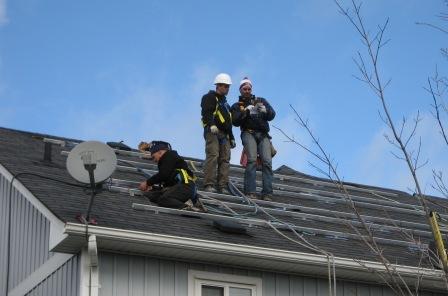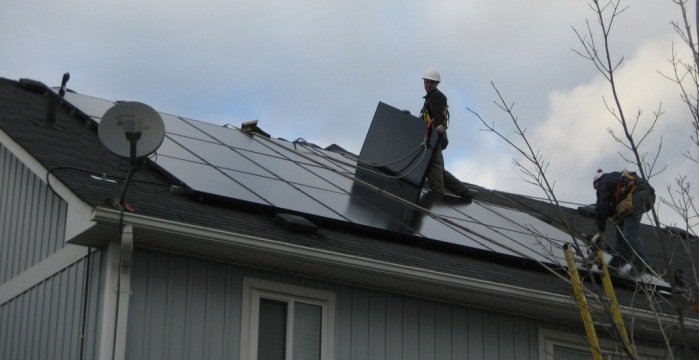Our New Solar Rooftop
An Ontario MicroFIT Success Story
Green Basics Advanced Green Steps Speaking Green Success Stories

Green Basics Advanced Green Steps Speaking Green Success Stories
|
Home > Green Success Stories > Our New Solar Rooftop |
 As published by the Brooklin Town Crier - November 19, 2010
As published by the Brooklin Town Crier - November 19, 2010
by Scott Bennett
 On November 1st our family began generating electricity from the 20 newly-installed solar panels on our roof. We are supplying green electricity to the province through our solar panels, and it is the start of a growing trend. There are three homes in Whitby, one in Ashburn, and a farm at Lakeridge and Brawley that are currently generating solar electricity under the Ontario microFIT program. There are another 20 in the works in the area according to Whitby Hydro.
On November 1st our family began generating electricity from the 20 newly-installed solar panels on our roof. We are supplying green electricity to the province through our solar panels, and it is the start of a growing trend. There are three homes in Whitby, one in Ashburn, and a farm at Lakeridge and Brawley that are currently generating solar electricity under the Ontario microFIT program. There are another 20 in the works in the area according to Whitby Hydro.
The solar industry has boomed in Ontario in the past year. For example, a few years ago there were two solar installers in Kingston; today there are more than 40.
The Ontario government created the microFIT program to encourage home owners and businesses to generate clean electricity in an effort to help phase out dirty coal-fired generators (the carbon dioxide from these generators is the equivalent of almost 7 million cars on the road per year). While the program covers electricity generated by various sources (e.g., wind, hydro, etc.), it pays the highest rate for electricity generated from solar. The Ontario microFIT contract with the government is for a 20 year period at a guaranteed rate to encourage an investment in green technologies (also known as "clean tech"). The response to the program has been overwhelming. It took about four months for our application to be processed before we received a conditional contract.
Generating electricity with solar panels is referred to as solar photovoltaic (or solar PV for short). The amount of energy you can produce from a rooftop depends on a few things, but mostly on location, location, location. Homeowners in California get more sunshine than Toronto, so geography plays a role in the potential for solar energy. The orientation of your roof is also very important, as the south and southwest-facing roofs get the most sunshine. The ideal location should also get full sunshine and not shaded part way through the day from something such as a tree. In our case, we have a South facing roof with no obstructions - perfect!
There are two tough decisions to make in setting up a solar project. One is who to contract to do the work (the most experienced pros are the best) and the other is what brand and model of solar panels to use. These are tough choices because there are so many options. I was lucky to find my solar installer on an eco-house tour this spring. This company setup the first off-grid winery in Canada (near Picton). I talked to the owners of Red Tail Winery and also compared proposals from other solar companies before choosing Steve Eng from Enviro-Energy Technologies to do the installation.
There are many different types of solar panels available, but, after careful consideration, we chose the more expensive SunPower solar panels because they produce energy from a broader spectrum of light than most other panels. This means that, even on a rainy day, our solar panels will generate some electricity. If you want to see how much electricity we're generating from our 20 solar panels as you're reading this, you can see the results in real-time on the web at www.carbondiet.ca/solar (click on the bar graph icon).
You may be wondering why Laurie and I decided to install solar panels. Well, it's for two reasons. One, we believe we need to do what we can to reduce our impact on the environment, and a large portion of our family's carbon footprint is from electricity. Secondly, with a 20 year fixed price contract, solar panels with a 25 year warranty, and a 9.5 year payback period, we figured it was a reasonable investment too.
Some friends have asked me "what if you move?". The contract is transferrable to the new home owner and with an income stream of about $4,000 per year, who wouldn't be willing to pay more for our house? It's like having a silent tenant on your roof.
We're proud of the step we've taken to make the world a greener place, and I hope to see more solar-powered rooftops in Brooklin. This has been a great Ontario microFIT success story.
For more ideas on how to go green, see our energy saving tips.

Related Green Success Stories
Solar Water Heater
Solar Water Heating Installer
Geothermal Heating and Cooling
On Demand Water Heater
Green Cleaning Success